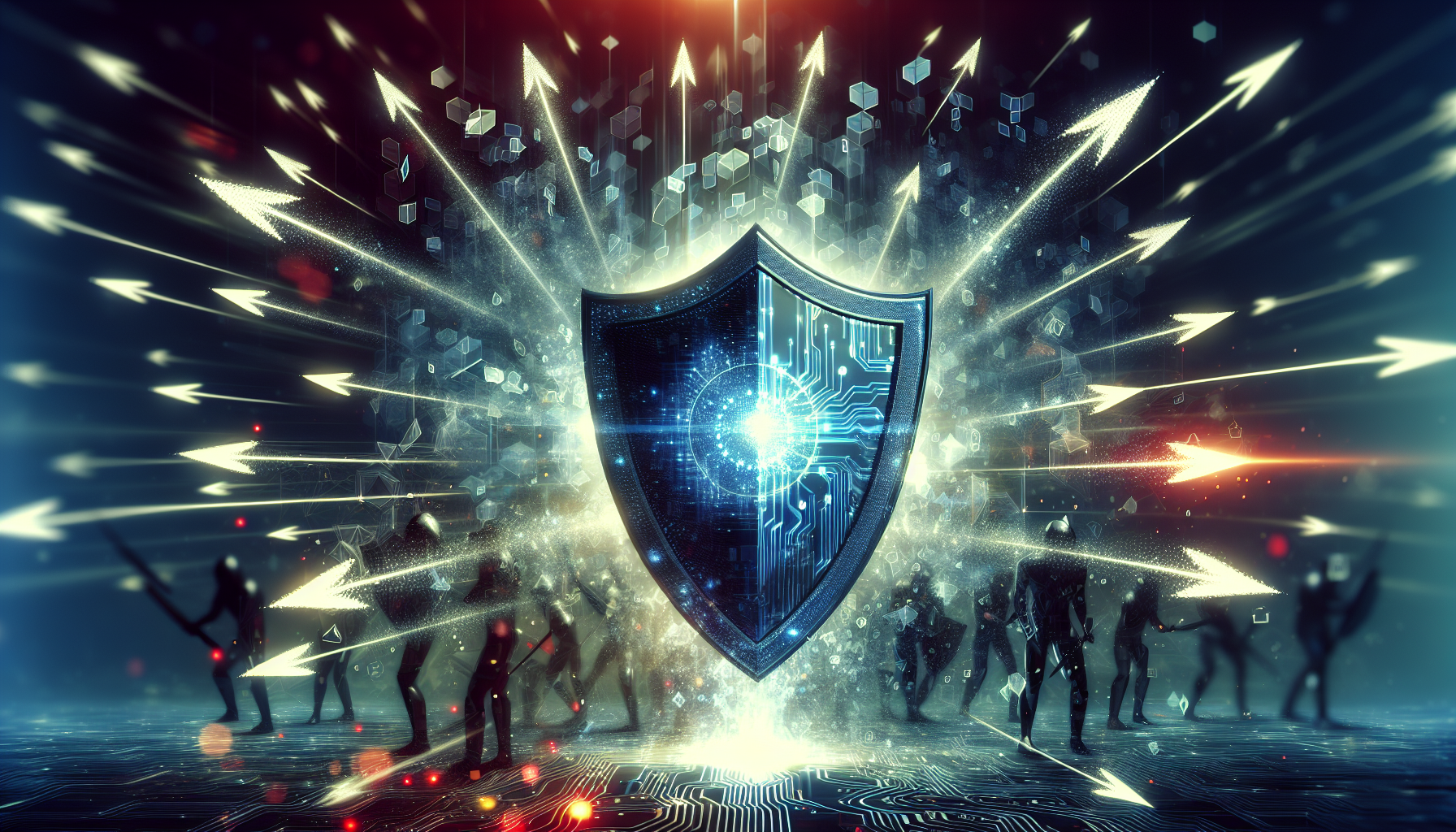Top Strategies to Prevent Cyber Attack in Today’s Digital Landscape
Are you equipped to prevent cyber attack? Your search ends here. This article demystifies how to counteract these digital threats, offering you a concise playbook of proven preventative tactics. Anticipate insights into the realities of cyber attacks and straightforward tips to shield your systems effectively.
Key Takeaways
- Cyber attacks are deliberate exploitations of systems and networks which pose significant risks including theft of sensitive data, operational disruption, and damage to reputation; understanding the types of attacks and their potential consequences is essential for cybersecurity.
- To prevent cyber attacks, robust security measures must be implemented, including layered security strategies, regular software updates, firewall and network security configurations, and endpoint protection to secure against known vulnerabilities and unauthorized access.
- Strengthen user access control through effective security policies, employee training on security practices, deployment of unique and strong passwords, and multi-factor authentication to greatly enhance the system’s security and protect user data.
Understanding Cyber Attacks

A cyber attack is a deliberate exploitation of systems and networks using malicious code to compromise data. Unauthorized access to computer systems can result in a range of potential threats, including the disruption of operations or the theft of sensitive information. In some cases, compromised systems may also be used to launch further attacks. Cyber attacks pose significant risks to individuals and organizations, making the prevention of these attacks an essential part of cybersecurity. Recognizing how a cyber attack occurred and how to prevent future attacks is a priority for maintaining cybersecurity.
The objectives of cyber attacks can include stealing, modifying, or removing access to valuable data, or causing a network to go down. Cyber criminals often cast a wide net when attempting to access valuable information, exploiting any vulnerable target they can find. The sophistication of cyber attacks and the potential consequences of cyber crime, such as financial losses and reputational damage, highlight the importance of cybersecurity for all individuals and businesses.
Types of Cyber Attacks
When we talk about cyber attacks, we’re referring to a broad category of malicious activities. Some common cyber attacks include:
- Malware: designed to harm or exploit any programmable device, service, or network
- Phishing attacks: deceive users into surrendering personal data
- Targeted phishing: like spear-phishing and whale-phishing, aim at specific individuals or high-profile targets
- Ransomware: malicious software that encrypts victims’ data, denying access until a ransom is paid.
Web-based systems face a variety of attacks, including:
- SQL injection
- DNS spoofing
- Cross-site scripting
- Stealthy Trojans
- Incapacitating DoS/DDoS attacks
- MITM attacks that can intercept or manipulate data in transit
By understanding the various types of cyber attacks, we can better arm ourselves with the right prevention strategies.
Potential Consequences
The potential consequences of cyber attacks are far-reaching and can have a severe impact on both individuals and organizations. For instance, cyber attacks can lead to direct financial loss through the theft of personal and financial information, and even identity theft. In addition to financial losses, cyber attacks can cause significant reputational damage, with far-reaching personal and safety implications.
Moreover, operational disruptions due to cyber attacks can impact a variety of systems and crucial infrastructure, ultimately affecting:
- businesses
- transportation
- power grids
- personal computers with various operating systems
- mobile devices
The potential consequences of cyber attacks underscore the importance of implementing robust cybersecurity measures to safeguard against these threats.
Implementing Robust Security Measures

To effectively prevent cyber attacks, it is crucial to implement robust security measures. This includes:
- Layered security measures encompassing physical, network, endpoint, application, and data security
- Creating a comprehensive defense strategy
- Supplemental security methods to enhance protection, as attackers can gain entry by exploiting employees
Even with antivirus and firewalls in place, these additional measures are necessary to ensure maximum security.
Technologies such as Security Information and Event Management (SIEM) systems are crucial as they analyze and correlate security alerts from across the organization’s IT infrastructure, enhancing overall security monitoring and management. Beyond these, enhancing endpoint security is critical, with proper configuration of both hardware and software and administrating control over privileges to guard against cyber exploitations.
Adopting a defense-in-depth strategy offers increased resilience against a range of cyber threats through an array of defensive mechanisms.
Regular Software and System Updates
One of the most effective ways to protect against cyber threats is through regular software and system updates. These updates are critical in cybersecurity to patch security vulnerabilities identified since the last release. Postponing software updates can leave systems unprotected against known vulnerabilities that hackers can exploit.
To ensure that these updates are timely, automation can be a useful tool. Automating software updates can help in maintaining up-to-date security without depending on manual user updates. A strategic approach to patch management is necessary, involving the prioritization of critical updates, testing before deployment, and auditing to ensure policy compliance.
By updating security measures regularly, organizations lower the risk of cyber attackers exploiting social engineering techniques.
Firewall and Network Security
Properly configured firewalls are a crucial component of any robust security system. They secure the network against unauthorized access, and regularly reviewing firewall rules and configurations can prevent security lapses due to unnecessary or outdated rules. A combination of hardware and software firewalls provides multiple layers of defense against external cyber threats.
Firewall policy must be compliant with industry regulations and standards to ensure network security. Regular auditing of firewall software and log analysis ensures up-to-date protection and prepares the network for forensic investigations when necessary. Firewalls with enhanced capabilities such as website reputation services offer added protection by blocking insecure or unnecessary services.
Including Intrusion Detection Systems (IDS) or Intrusion Prevention Systems (IPS) as complementary measures to firewalls improves monitoring for suspicious activities.
Endpoint Protection
Endpoint protection is another crucial element of a robust cybersecurity strategy. This includes security software such as antivirus and antimalware installed on all endpoint devices to detect and remove malicious software. In addition to this, personal firewalls on devices manage network traffic based on security rules.
Secure VPN access and mobile device management solutions are essential for remote workers to ensure encrypted connections and allow secure device monitoring and management, especially when using mobile phones. Some key tools for remote workers include:
- Secure VPN access
- Mobile device management solutions
- Multi-factor authentication
- Ongoing detection mechanisms
These tools provide an additional security layer for remote access, notifying IT departments about potential threats promptly and enabling immediate threat identification and swift incident response, while also eliminating unsecure or unnecessary services.
Strengthening User Access Control

Strengthening user access control is another crucial aspect of cyber attack prevention. This can be achieved through:
- Creating and enforcing effective security policies to establish employer expectations and a secure environment for sensitive data
- Limiting and monitoring user access through the principle of least privilege
- Leveraging network segmentation to minimize the risk of unauthorized data access.
To reinforce security-conscious behavior, here are some recommendations:
- Use a trust scoring system to hold entities accountable for their security practices
- Avoid common passwords
- Use a password manager
- Ensure strong, unique passwords for each system and application
Using the same password setup for everything is hazardous, as it can give hackers access to the entire system upon decrypting a single password.
Employee Training
One of the most effective ways to strengthen user access control is through employee training, which includes educating them about normal users execution permissions. Security awareness training not only fulfills compliance requirements but also demonstrates social responsibility and a return on investment by reducing the number of cyber incidents. Modern security awareness training is designed to be dynamic, engaging, and interactive, moving away from the focus on technical concepts and compliance of traditional training.
Effective employee training strengthens the human aspect of cyber defenses, helping staff to correctly utilize security tools and adhere to compliance requirements. Regular, updated cyber security training equips employees with current information on threat prevention, contributing to overall improved security posture.
Unique and Strong Passwords
Passwords are the first line of defense in cyber security. A longer password is generally more secure than a shorter one, hence length is a critical factor in creating a strong password. Complex passwords that include a mix of upper and lower case letters, numbers, and special characters are more robust.
Constructing a password from sentences or phrases, such as ‘breadandbutteryum’, can help in creating something secure yet memorable for the user. Avoid using readily accessible personal information in passwords, such as birthdays or pet names, to prevent easy guessing.
Employing different passwords for each account minimizes the risk of multiple accounts being compromised in the event one is breached. Password managers, including:
- PassPortal
- KeePass
- Keeper
- Password Safe
assist in managing a collection of strong, unique passwords and keeping them secure.
Multi-Factor Authentication
Another effective way to strengthen user access control is through multi-factor authentication. This provides additional security layers and reduces the chance of consumer identities becoming compromised, thereby protecting sensitive data. Implementing multi-factor authentication can help protect against:
- Social engineering schemes that rely on increasing privilege levels to gain access
- Password theft or guessing
- Phishing attacks
- Credential stuffing attacks
By implementing multi-factor authentication, you can significantly enhance the security of your system and better protect your users’ data.
User accounts on firewalls require multi-factor authentication and role-based access control (RBAC) to further enhance security. Using multi-factor authentication assures consumer identity protection against identity theft as time-sensitive and non-reusable codes, such as TOTPs, are challenging for cybercriminals to crack. The implementation of multi-factor authentication is a straightforward and non-invasive process that preserves the user-friendly aspect of the organization’s virtual environments.
To learn more about the importance of 2FA, check out of Tech Tip Happy Hour!
Safeguarding Sensitive Information

Safeguarding sensitive information is a central component of cyber attack prevention. Encrypting sensitive information ensures that even if data is compromised, it is unreadable without the appropriate decryption keys. Performing regular backups retains a copy of sensitive information, which can be crucial for recovery efforts after a data breach or cyber attack.
Continuous monitoring allows for the early detection of suspicious activities, reducing the time frame within which cyber attackers can operate. A predefined incident response plan enables organizations to quickly and effectively address security incidents, mitigating potential damage. A combined approach of encryption, backups, and active monitoring with a ready incident response forms a robust strategy for protecting sensitive information against cyber threats.
One way to Safeguard your information is to use Microsoft Secure Solutions. Check out more, here!
Data Encryption
Data encryption is a vital tool in safeguarding sensitive information. It translates data into a form that is unreadable without a decryption key or password, ensuring that sensitive information remains confidential and secure. There are two primary forms of data encryption – asymmetric encryption, which uses public and private keys, and symmetric encryption, which uses the same key for both encryption and decryption.
The strength of encryption is influenced by key size, with larger keys providing stronger encryption but requiring more computing power. Securing internet communications with technologies like SSL certificates is crucial to prevent unauthorized interception and access to data being transmitted over the web.
Virtual Private Networks (VPNs) provide a secure encrypted tunnel for data transmission between remote devices and the corporate network, thereby safeguarding data from potential eavesdropping when users are working remotely.
Regular Backups
Regular data backups are another crucial aspect of safeguarding sensitive information. These are essential in cybersecurity for ensuring that data can be restored in case primary data is compromised. Following the 3-2-1 backup strategy – keeping three copies of the data on two different storage media, with one copy stored offsite – can increase security.
Creating backups before implementing system updates is crucial so that systems can be restored if an update leads to complications. In today’s digital world, where data is a precious commodity, regular backups serve as insurance against the unexpected loss of critical information.
Monitoring and Incident Response
Continuous monitoring of critical systems, including the operating system, is essential for the early detection of unusual or potentially harmful activities prompted by social engineering tactics. A Security Operations Center (SOC) plays a critical role in analyzing logging and audit information round the clock to respond to cyber threats effectively.
Identifying vulnerabilities through regular security audits, penetration tests, and the use of vulnerability scanning tools is key to detecting potential cyber threats. An organized and swift incident response is vital, involving:
- Mobilization of cybersecurity staff
- Identification of the attack type
- Containment of the breach
- Assessment and repair of damage
Reporting of suspicious activities helps to prevent further consequences and mitigate the impact of a cyber attack.
Mitigating Social Engineering Attacks

In addition to the technical aspects of cybersecurity, it’s also vital to consider the human element. Social engineering attacks play on human psychology and trick individuals into revealing sensitive information. Educating employees about social engineering and the various tactics used by attackers is key to defending against these threats.
Utilizing secure, encrypted communication channels can significantly reduce the risk of sensitive information being intercepted or manipulated by social engineers. Verification procedures such as confirming requests through multiple channels and requiring managerial approval for sensitive transactions can hinder social engineering efforts. Let’s delve deeper into the strategies for mitigating social engineering attacks.
Awareness and Education
Consistent social engineering awareness training integrated into company culture is fundamental to transforming employees into an active line of defense against cyber threats. Employees should receive regular social engineering training sessions, at least monthly, complemented by ongoing reminders to keep security top-of-mind.
Practical training exercises, such as phishing simulations, are effective in teaching employees to recognize and respond appropriately to social engineering tactics. A culture that values skepticism enables employees to comfortably question and report unusual or suspicious behavior, enhancing the overall cybersecurity posture of the organization.
Secure Communication Channels
Secure communication channels are a key component in mitigating social engineering attacks. Encrypted communication channels, such as secure email services, secure file transfer protocols, and encrypted messaging apps, can help protect sensitive information from being intercepted or manipulated by social engineers. This becomes particularly crucial when handling sensitive customer information or transmitting confidential business data.
In addition to utilizing secure communication channels, it’s also important to have protocols in place for verifying the authenticity of the communication. This can involve measures such as two-factor authentication, digital signatures, and secure VPN connections for remote workers. These measures can provide an additional layer of security, making it harder for social engineers to gain access to sensitive information.
Verification Procedures
Verification procedures play a crucial role in mitigating social engineering attacks. Establishing strict policies for verifying important procedures, such as money transfers, can mitigate the risk of social engineering tactics such as CEO fraud. Implementing face-to-face confirmation for significant financial transactions is an effective layer of defense in verifying the authenticity of these actions.
Training employees to identify suspicious elements like spoof email addresses or unusual hyperlinks can strengthen verification procedures to counteract phishing and similar attacks. Verifying the identity of email senders is crucial for protecting against phishing attacks where perpetrators often impersonate trustworthy contacts.
Summary
In today’s digital landscape, cyber attacks pose a significant threat. However, with a comprehensive understanding of these threats and the implementation of robust security measures, we can significantly reduce the risks. From regular software updates and firewall security to employee training and multi-factor authentication, each strategy plays a crucial role in building a strong line of defense against cyber threats.
As we navigate through the digital jungle, it is essential to remember that cybersecurity is not a one-time task but an ongoing process. It requires continuous monitoring, regular updates, and constant vigilance. So let’s stay alert, stay informed, and stay secure!
Frequently Asked Questions
How cyber attacks can be prevented?
To prevent cyber attacks, establish network perimeter defenses such as firewalls, internet gateways, and web filtering. Additionally, use strong, unique passwords and verify the authenticity of links before clicking on them.
What is the strongest prevention against cyber threats?
The strongest prevention against cyber threats is to monitor the activity of privileged and third-party users in your organization’s IT environment, use multi-factor authentication, update software regularly, and use strong passwords. These measures help protect sensitive data and reduce the risk of cybersecurity breaches.
What are the 3 main ways to prevent security threats?
To prevent security threats, you can install antivirus software, create strong passwords, and enforce security policies. These steps will help protect your network from malware and other potential threats.
What is a cyber attack and how can it affect individuals and organizations?
A cyber attack is a deliberate exploitation of systems and networks using malicious code to compromise data. It can lead to significant risks to individuals and organizations, including financial loss, reputational damage, and operational disruptions.
How can regular software and system updates help in preventing cyber attacks?
Regular software and system updates are crucial in cybersecurity as they patch security vulnerabilities identified since the last release. By keeping software and systems updated, we can protect against known vulnerabilities that hackers could exploit. This helps in preventing cyber attacks.







